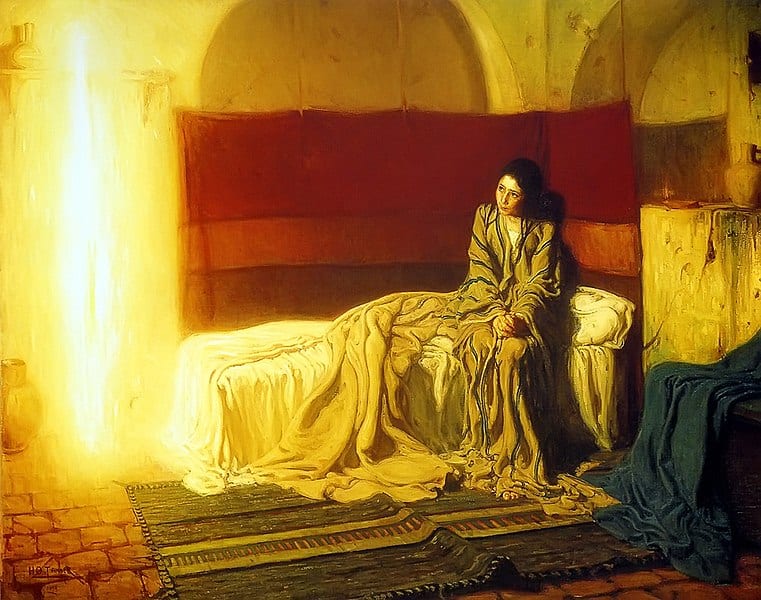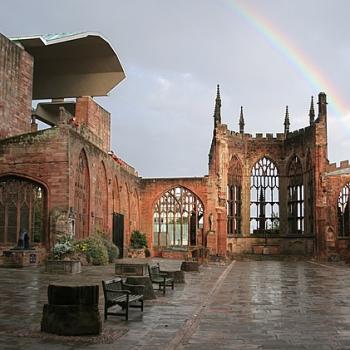
(Wikimedia Commons public domain image)
“Lift up your head and be of good cheer; for behold, the time is at hand, and on this night shall the sign be given, and on the morrow come I into the world, to show unto the world that I will fulfill all that which I have caused to be spoken by the mouth of my holy prophets” (3 Nephi 1:13).
***
In this clip, Chanticleer performs what I, at least, consider to be one of the most achingly, exquisitely beautiful pieces of music ever composed, Franz Biebl’s 1964 setting of “Ave Maria”:
https://www.youtube.com/watch?v=XVyCJlPiHFg
V. Angelus Domini nuntiavit Mariæ.
R. Et concepit de Spiritu Sancto.
Ave Maria, gratia plena, Dominus tecum. Benedicta tu in mulieribus, et benedictus fructus ventris tui, Iesus.
V. Maria dixit: Ecce Ancilla Domini.
R. Fiat mihi secundum Verbum tuum.
Ave Maria, gratia plena, Dominus tecum. Benedicta tu in mulieribus, et benedictus fructus ventris tui, Iesus.
Sancta Maria, Mater Dei, ora pro nobis peccatoribus, nunc et in hora mortis nostræ. Amen.
My translation:
The angel of the Lord appeared unto Mary,
And she conceived of the Holy Spirit.
Hail, Mary, full of grace. The Lord is with thee. Blessed art thou among women, and blessed is the fruit of thy womb, Jesus.
Mary said, “Behold the handmaiden of the Lord.
Let it be unto me according to thy word.”
Hail, Mary, full of grace. The Lord is with thee. Blessed art thou among women, and blessed is the fruit of thy womb, Jesus.
Holy Mary, Mother of God, pray for us sinners, now and at the hour of our death. Amen.
There is horrifying evil, hatred, and ugliness in the world. But there is also great goodness and beauty. This piece offers a glimpse and a reminder of that.
***
Here’s a thrilling Nigerian carol, Betelehemu, sung in the original Yoruba by — of all people! — the Tabernacle Choir at Temple Square in Salt Lake City:
https://www.youtube.com/watch?v=N9gXWuqZcNw
Awa yo, a ri Baba gb’ojule (We rejoice for we have a trustworthy father)
Awa yo, a ri Baba f’eyin ti (We rejoice for we have? a dependable father)
(repeat)
Ni bo labe Jesu? (Where was Jesus born)
Ni bo labe bisi? (Where was he born?)
(Repeat)
Betelehemu iluwa la, (Bethlehem, city of wonder)
Ni bo labe Baba o daju (That is where Father was born)
Inyi, inyi, furo (Praise, praise, be to Him)
Adupe fun o, jooni, (We thank you, today)
Baba olo reo (Gracious Father)
It’s a spectacular crowd-pleaser.
Listen to and watch the entire thing.
***
A remarkable a cappella version of a very popular Christmas carol:
https://www.youtube.com/watch?v=qJ_MGWio-vc
The carol was written by Katherine Kennicott Davis, an American classical music composer and teacher, in 1941. (She originally called it “The Carol of the Drum.”) The Trapp Family Singers — think The Sound of Music — recorded it in 1955 and it became even more popular when the Harry Simeone Chorale recorded it in 1958.
I’m guessing that the latter may have been the version that I first encountered; I vaguely remember hearing the carol as “new” when I was a very little boy — on the radio, while riding in our family car down the main drag in Alhambra, California, underneath the street’s Christmas lights, which were a highly anticipated and wonder-inducing sign of the season every year of my childhood — and loving it. That was a magical moment, which is why it remains, among my earliest memories.
***
I heard the King’s Singers perform this wonderful Catalonian carol in Salt Lake City’s Conference Center:
¿Qué le daremos al Niño chiquito
Con que se pueda reír y alegrar?
Un lindo ramo de hermosas naranjas
Con verdes hojas y flor de ahazar
Tan ta, ran tán
Que los higos son verdes
Tan ta, ran tán
Que ya maduraran
¿Qué le daremos, qué le daremos?
Frum, frum
¿Qué la daremos al Niño bonito
Qué le daremos major para Él?
Vamos a hacerle unas tortas muy dulces
De Blanca harina, de nueces y miel
¿Qué le daremos al Niño querido
Que sea bueno y le pueda gustar?
Vamos a darle una cesta de guindas
Para comerlas o para jugar.
Unfortunately, their performance there is no longer available online. So here it is, performed in English by the Tabernacle Choir:
https://www.youtube.com/watch?v=fH9nK_9OBDg
***
The so-called “Wexford Carol,” which comes from Ireland’s County Wexford and which seems to date back to the twelfth century, may be among the oldest Christmas carols — and, thus, among the oldest pieces still performed — in the Western musical tradition:
***
I have a sad confession to make: I’ve heard and sung the carol Silent Night so very many times over the course of my ridiculously many decades of mortal life that its impact on me has, I regret to say, been blunted a bit.
But BYU produced a very nice film about the genesis of the carol two or three years ago. Strikingly, it received a Catholic film award.
If you get a chance to see the film — here, for example — please do.
In the meantime, here’s a performance of the carol by the Vienna Boys Choir, accompanied by beautiful photographs.
***
The first recording of Do You Hear What I Hear? was made by the Harry Simeone Chorale shortly after Thanksgiving 1962, and sold so well during that Christmas season that Bing Crosby eventually recorded it also — making it, by means of his star power, a mega-hit.
Here is that very first choral recording:
https://www.youtube.com/watch?v=dUbD0BK2vFU
The song had been composed only a month or so before, during the thirteen days of the Cuban missile crisis of October 1962, when — and I still have vivid childhood memories of this — the world seemed to be within hours of a nuclear war between John F. Kennedy’s United States and Nikita Krushchev’s Soviet Union. It was written as a plea for peace, and that can clearly be heard in the words.
The lyrics of the song are constructed somewhat like a game of “telephone,” with the news of Christ’s birth being related by the night wind to a lamb, by the lamb to a shepherd boy, by the shepherd boy to a king, and by the king to people everywhere. At each level, the nature of the message changes somewhat, becoming more specifically focused on Christ.
***
I asked my Havana-born daughter in law for some recommendations of Spanish Christmas carols. Here are two of them: The first is the famous “Feliz Navidad.” the second is “Mi Burrito Sabanero”:
Con mi burrito sabanero, voy camino de BelénIf they see me, if they see me
Si me ven, si me venI am going to belen road
Voy camino de BelénThe morning light illuminates my path
El lucerito mañanero ilumina mi sendero
Con mi cuatrico voy cantando, mi burrito va trotando
Tuki tuki tuki tukiTuki tuki tuki ta
Tuki tuki tuki taHurry up my burrito
Apúrate, mi burritoThat we are going to arrive
Que ya vamos a llegarLet’s see jesus
Vamos a ver a JesúsWith my quad I sing, my little donkey is trotting
Con mi cuatrico voy cantando, mi burrito va trotandoIf they see me, if they see me
Si me ven, si me ven
I am going to belen road
Voy camino de Belén
If they see me, if they see me
Si me ven, si me ven
I am going to belen road
Voy camino de Belén
Tuki tuki tuki tukiTuki tuki tuki ta
Tuki tuki tuki taHurry up my burrito
Apúrate, mi burritoThat we are going to arrive
Que ya vamos a llegar
Tuki tuki tuki tukiTuki tuki tuki you
Tuki tuki tuki tu












